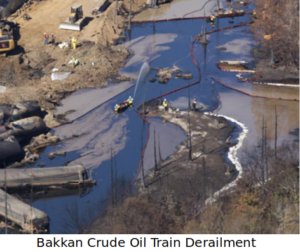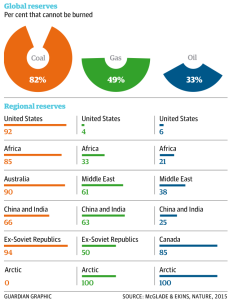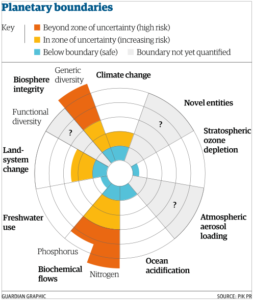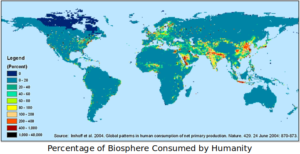For anyone paying attention, and who takes the scientific data seriously, it’s understood that the surviveability of humans and up to 50% of other species is in peril. The threat is not just climate disruption. It’s just that the harsh and widespread impact of climate disruption is tangible in a way that tends to be convincing. Other not-so-obvious ways that threaten the planet’s livability are what Swedish environmental science professor, Johan Rockstrom, calls the Nine Planetary Boundaries. They include: lost biodiversity as species become extinct, deforestation and other land use changes, ocean acidification, freshwater depletion, and dumping of chemical, radioactive, and plastic pollutants into the environment, to name a few – Earth is halfway to being inhospitable to life – Planetary boundaries. The impact of these tend to be incremental and scatter-site, and not as apparent as extreme climate events until some cumulative threshold is passed, and disaster strikes. Even then, the cause and effect is often difficult to connect.
Pollution dumping as a breach of an Earth Boundary holds a unique place among the various boundaries. Chemicals, radioactivity, and plastics are all products of the energy sector, which for 150 years has been extracting non-renewable fossil and nuclear fuels from the Earth. The pollutants that accompany this extractive onslaught are the consequence of our ravenous energy appetite. And an unrestrained fossil energy appetite is the primary driver of transgressions against all the other Earth Boundaries – climate disruption from greenhouse gases, deforestation from energy extraction, ocean acidification from greenhouse gases, freshwater depletion from energy extraction and chemical pollutants, land and waterways pollution from synthetic farm chemicals, and more. It all starts with non-renewable energy extraction. That’s the underlying cause, and everything else is a consequence. Non-renewable energy is THE problem.

People and groups who have been confronting the range of issues we are discussing have usually grappled with one narrow aspect at a time, because that’s at a scale they can manage. But they often fail to see the forest for the trees – that energy is at the root of their local issue. Multiple groups attacking distinct angles of an issue can work well, as in “death by 100 cuts”, so long as they all view it in the context of non-renewable energy being the ultimate problem. Now, if this editor’s read of history is correct, mass protest groups first looked beyond a local issue and cited global fossil energy as the problem when First Nations People in both Canada and the U.S. tackled pipelines and tarsands mining. Tribes and coalitions such as Silent No More and Water Protectors said the solution to all energy justice issues was to “Keep it (fossil energy) in the ground”. If we don’t burn fossil fuels, we won’t suffer the consequences.
As a strategy, “keeping it in the ground” stops ecological and social damage on many fronts simultaneously. With no fossil fuel use, the land, water, and air, and vulnerable populations as well will all be protected – done! The idea is captivating, and has become a rallying cry. For more than a decade, analysts have run at least 40 different computer models to show that 80% or more of fossil fuel reserves must remain in the ground if we hope to regain a livable atmosphere. Bill McKibben explained that of the 2,795 gigatons of carbon in the proven coal and oil and gas reserves, all must remain untapped except for 565 gigatons to keep the planet below 2°C warming (and we now know that 1.5°C is the safe level) – Global Warming’s Terrifying New Math.

So here’s the conundrum. Stopping the social and ecological damage of fossil (and nuclear) energy is one half of the equation. By doing that, it should be noted that the equation’s other half will also stop most of modern society’s functions. In rough numbers, non-renewable energy currently supports: 95% of electricity supply, 95% of transportation fuels, 95% of building heating, 80% of food production from synthetic inputs, 75% of consumer products based on plastics (including the computer you’re reading this on), and 50% of building materials based on oil-derived adhesives, coatings and finishes. All this goes out the window with non-renewable energy. Obviously, to curtail society’s non-renewable energy use so drastically will require two alternative tactics: generation of non-fossil-derived materials and fuels, but even more so, adoption of more frugal lifestyles. Finding substitutes to completely replace the non-renewable inputs of modern society is a tall order, especially before the climate target dates at mid-century. For example, renewable electricity is a particularly daunting challenge – The Global Energy System Is Becoming More Electric, But Not Fast Enough, and At this rate, it’s going to take nearly 400 years to transform the energy system.

As far as is known, the other eight Earth Boundaries have no target dates like climate warming, other than “urgent”. According to the National Academy of Sciences, the human appropriation of net primary production (HANPP) of the Earth is above 25%, and trending to 30% by mid-century. HANPP measures the units of carbon per year expropriated by humans from biomass, including crops, timber, livestock forages, human caused fires, and conversion of forest to cropland or urbanization. The more taken by humans, the less available for other species – Global human appropriation of net primary production doubled in the 20th century. The Global Footprint Network noted that 1 August 2018 was this year’s Earth Overshoot Day, when humanity’s total annual demand on nature exceeded what Earth’s ecosystems can regenerate in that year – Earth Overshoot Day 2018 is August 1, the earliest date since readings done. And a report by twenty two scientist entitled the “Global Environment Outlook” from the United Nations Environmental Program (UNEP) noted that once 50-90% of an ecosystem is altered, it risks imminent collapse. On a global scale they indicated that 43% of the world’s terrestrial ecosystems have been converted to agriculture or urban use, and unless patterns of human consumption are greatly reduced, by 2025 half of the world’s land surface will have been altered. Lead author Anthony Barnosky warned “We want to stay away from that 50%” – Scientists: if we don’t act now we’re screwed.

Whatever way you cut it, human impacts on the planet, climate and otherwise, are stressing the ecosphere to the limit. Curtailing fossil and nuclear energy is imperative to bring the Earth back from the brink, but will have far reaching implications for human societies. A look at climate disruption and coming to grips through some realistic scenarios is explored in this in-depth article – Real ambition on global warming: what it would look like. It generally applies to the other Earth Boundaries as well. Whatever scenario is preferred, it will need to entail a range of tactics, all pursued simultaneously, to reach zero carbon or better yet negative carbon. By our assessment, the following are the minimum key goals of any prescription to lower the fever of the planet.
- Keep non-renewable fuels in the ground: More than 80% of fossil fuel reserves must remain in the ground if we hope to regain a livable atmosphere – Global Warming’s Terrifying New Math..
- Invest in 100% renewable electricity: The annual U.S. $20billion subsidies of fossil fuels and the hundreds of $billions invested by global banks in fossil fuels must shift entirely to renewable energy – World’s Biggest Banks Are Driving Climate Change, Pumping Billions Into Extreme Fossil Fuels.
- Electrify all end uses: With some exceptions like heavy transport and blast furnaces, applications of space heating, light transport, motor drive, and industrial boilers and process heating are prime targets for electrification – Enter the electrification of everything.
- Enhance and utilize ecosystem services: Ecosystem services support humans, like carbon sequestration, pollination, and water purification. Compromised systems mean that human labor and technology must perform the functions at our expense – Ecosystem Services.
- Drawdown CO2: Excess CO2 must be removed from the atmosphere to regulate the Earth’s temperatures at a safe level. Drawdown can be facilitated by a full range of solutions, both technical and natural – Drawdown Solutions.
- Polluter pays: One way the rich get rich is by privatizing profits while socializing the costs, such as not paying to dump pollution, forcing society to either pay for clean-up or suffer illness. The Polluter Pays Principle is recognized by law, but not applied consistently nation to nation – What is the polluter pays principle?.
- Forest protection and reforestation: Reforestation is the most effective “carbon negative” solution, whereas carbon capture and sequestration is expensive and unproven – Nature could suck up 21 percent of our greenhouse emissions (with a little help).
- Indigenous Peoples’ Land Management: Indigenous land management conserves biodiversity, maintains ecosystems services, safeguards gifting cultures and traditional ways of life, and resists against deforestation and mineral, oil, and gas extraction – Indigenous Peoples’ Land Management.
- Reduced meat diet: The UN Food and Agriculture Organization reported that 17.4% of greenhouse gases (GHG) are produced by livestock. Cattle ranching accounts for 80% of Amazon deforestation, and 65% of U.S. farm manure is from CAFOs – Without changing human diets, it’s impossible to halt global warming.
- Frugal lifestyle at northern European consumption rates: The U.S. 5% of global population uses 25% of the world’s fossil fuels. Per capita emissions in the U.S. are three times as high as in Denmark. Frugality is pocketbook and planet friendly – Capital Accumulation and Opting Out of the Consumerist Machine.
- Raise soil organic matter to 10%: Fertile soils have up to 10% carbon, but chemical farming reduces that to near 2%. Adding carbon back through no-till cover crops, perennial cropping, and biochar will sequester CO2 as well as recreate fertile soils and enable organic agriculture – Soil as Carbon Storehouse: New Weapon in Climate Fight?.
- Educate girls: Women with more years of education have fewer and healthier children. This is one of the most powerful levers to cut emissions by curbing population growth – Educating Girls.
- Population reduction to 2 billion humans: Per capita conservation of energy and resources can reduce climate emissions, but only if population doesn’t outpace frugality. Continued exponential population growth is a dead end on a finite planet – Too Many People, Too Much Consumption.


Recent Comments